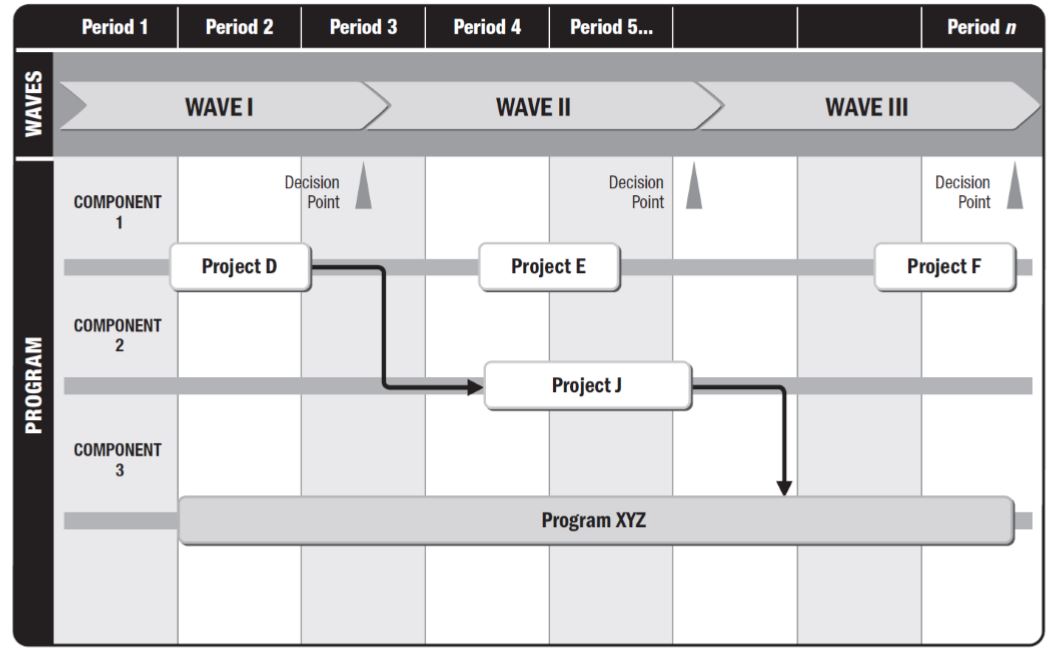Program strategy alignment is a program performance domain that is initiated during the program definition phase with the development of the business case, program charter and program roadmap, supported with the inputs from environmental assessments and program risk management strategy.
The effort results in the development of a program management plan that is aligned with organizational goals and objectives.
 Organization strategic plan
Organization strategic plan
It is important to understand how the Strategic development process. In this way, if we do the process in the right way, we will be able to link the program initiatives with the organization goals and objectives.
1. Program Business case
http://joapen.com/blog/2018/10/08/program-business-case/
2. Program Charter
http://joapen.com/blog/2018/10/08/program-charter/
3. Program Roadmap
The program roadmap is a chronological representation of a program’s intended direction, graphically depicting dependencies between major milestones and decision points, which reflects the linkage between the business strategy and the program work.
The program roadmap also reflects the pace at which benefits are realized and serves as a basis for transition and integration of new capabilities.
 4. Environmental assessment
4. Environmental assessment
There are often internal or external influences to the program that have a significant impact on a program’s success.
Program managers should identify these influences program in order to ensure ongoing stakeholder alignment, the program’s continued alignment with the organization’s strategic goals and objectives, and overall program success.
Enterprise Environmental Factors
Enterprise environmental factors external to the program may influence the selection, design, funding, and management of a program.
Environmental factors may include but are not limited to:
- Business environment;
- Market;
- Funding;
- Resources;
- Industry;
- Health, safety, and environment;
- Economy;
- Cultural diversity;
- Geographic diversity;
- Regulatory;
- Legislative;
- Growth;
- Supply base;
- Technology;
- Political influence;
Environmental Analysis
The following sections outline various forms of analysis that may be used to assess the validity of a program’s business case and program management plan.
- Comparative Advantage Analysis: Where appropriate, comparative advantage analysis may also include what-if analyses to illustrate how the program’s objectives and intended benefits could be achieved by other means.
- Feasibility Studies: Using the business case, organizational goals, and other existing initiatives as a base, this process assesses the feasibility of the program within the organization’s financial, sourcing, complexity, and constraint profile.
- Swot Analysis: An analysis of the strengths, weaknesses, opportunities, and threats (SWOT) faced by a program provides information for optimizing the program charter and program management plan.
- Assumptions Analysis: Program managers regularly identify and document assumptions as part of their planning process. In addition, assumptions should be validated during the course of the program to ensure that the assumptions have not been invalidated by events or other program activities.
- Historical Information: Analysis Historical information includes artifacts, metrics, risks, and estimations from previous programs, projects, and ongoing operations that may be relevant to the current program. Historical information describing the successes, failures, and lessons learned is particularly important during program definition.
5. Program Risk Management Strategy
Successful delivery of the program roadmap, aligned with organizational strategy, and with consideration to the environmental factors found in the environmental assessments, depends on a well-defined program risk strategy.
- Risk Management For Strategy Alignment: This risk management strategy includes defining program risk thresholds, performing the initial program risk assessment, and developing a high-level program risk response strategy.
- Program Risk Thresholds: Risk threshold is the measure of the degree of acceptable variation around a program objective that reflects the risk appetite of the organization and program stakeholders.
- Initial Program Risk Assessment: While program risk management is conducted throughout the life of the program, the initial program risk assessment, prepared during program definition, offers a unique opportunity to identify risks to organizational strategy alignment.
- Program Risk Response Strategy: Program risk response strategy combines the elements of the risk thresholds and the initial risk assessment into a plan for how program risks will be managed effectively and consistently throughout the life of the program.
- For each identified risk, the risk thresholds can be used to identify the specific response strategy based on a number of rating criteria.
- A robust program risk management strategy comprises a specific risk response strategy for each of the risk rating levels that have been developed to reflect the program’s risk thresholds.
Remember some basis concepts related to risks:
- Risk appetite: It is the degree of uncertainty an entity is willing to take on in anticipation of reward.
- Risk tolerance: It is the degree or volume of risk that an organization or individual will withstand.
- Risk threshold: it is the level of impact at which a stakeholder may have a specific interest.
